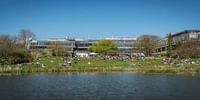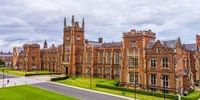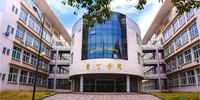This programme will give you advanced skills in computational modelling, numerical techniques and an in-depth understanding of engineering approaches to current aerospace problems. You will learn the research and experimental skills necessary to work in the aerospace engineering industry, whether as a researcher or as an engineer for a major aerospace company. You will also collaborate with researchers working on alternative fuels sources, so it is relevant and timely.
This programme will:
- Prepare you to develop new computational and technological products for the aerospace industries.
- Allow you to join research groups working at the cutting edge of aerospace engineering, and computational modelling.
- Give you the chance to specialise in your own area.
The School of Engineering and Materials Science (SEMS) undertakes high quality research in a wide range of areas. This research feeds into our teaching at all levels, helping us to develop very well qualified graduates with opportunities for employment both in many leading industries as well as in research. Both Engineering and Materials are very well established at Queen Mary, with the Aerospace Department being the first established in the UK. Our aerospace teaching programmes were ranked number two in the UK in the 2011 National Student Survey.
- This MSc programme is available to students from a variety of non-engineering backgrounds such as Physics, Maths, and Electronic Engineering.
- It was the first of its kind in the country; offering some unique modules including, aeroelasticity, crash worthiness, and space engineering.
- Aerospace Engineering is an employment related field which allows you to keep up-to-date with the latest developments in design, aerodynamics, propulsion and technology.
Our postgraduate students enjoy a range of excellent resources, including:
- Comprehensive computing facilities: several high-performance PC clusters and parallel SGI computer clusters, and an extensive network of Linux and UNIX workstations.
- Extensive wind tunnel facilities: eight low speed wind tunnels, a very low turbulence wind tunnel, three high-speed wind tunnels, computer-based flow control system with high-speed, real-time data acquisition and processing system, colour and high-focused Schlieren systems, interactive aerodynamic simulator, and a PIV system.
- Experimental thermofluids engineering facilities: heat transfer and condensation rigs, six IC-engine test beds and three combustion rigs, laser Doppler anemometry, electron microscopy gas/particulate-sampling and analysis facilities, several exhaust gas sampling and testing kits for engine and combustion emissions and thermal instrumentation.
- Two new electrospray technology laboratories that were created with the support of the UK Joint Research Councils. The facilities include a wide range of instrumentation including a mass spectrometer capable of resolving high m/z particles up to 40,000, Fourier Transform Infra-Red Spectrometer, a wide-range, high-voltage power supply and a high speed camera.
- A cell and tissue engineering suite: this houses cell culture labs, a molecular biology unit with quantitative RT-PCR capability, and a radio-isotope labelling facility. A general purpose laboratory incorporates advanced mechanical test machines and standard biochemical/cell biology analysis equipment. The microscopy unit incorporates two confocal microscopes.
- The latest electron microscopes and a range of modern materials characterisation facilities including: FTIR and FT-Raman spectroscopy, x-ray fluorescence (XRF), inductively coupled plasma mass spectrometry, x-ray diffractometer (XRD), calorimetric (DTA, DSC) and thermomechanical (DMA, rheometer) techniques, analytical and computational facilities and image analysis, materials processing and fabrication, heat treatment equipment and dielectric and electrical characterisation.
- Thanks to a Royal Society Wolfson Grant we recently opened new laboratories to support functional materials research. The laboratories will hold the latest processing and characterisation equipment for organic solar cells.
- A new NanoVision Centre enhances the experimental nanomechanics and high resolution imaging capabilities of the School. The centre houses two high-resolution environmental scanning electron microscopes (SEM) one with an additional focused ion beam, a custom-built atomic force microscope and a cryo-sample preparation stage. Both SEMs incorporate the latest STEM technology and are supported by transmission electron microscopy. Our scanning probe laboratory contains two low-drift, high-stability closed loop Scanning Probe Microscopes (SPM).















